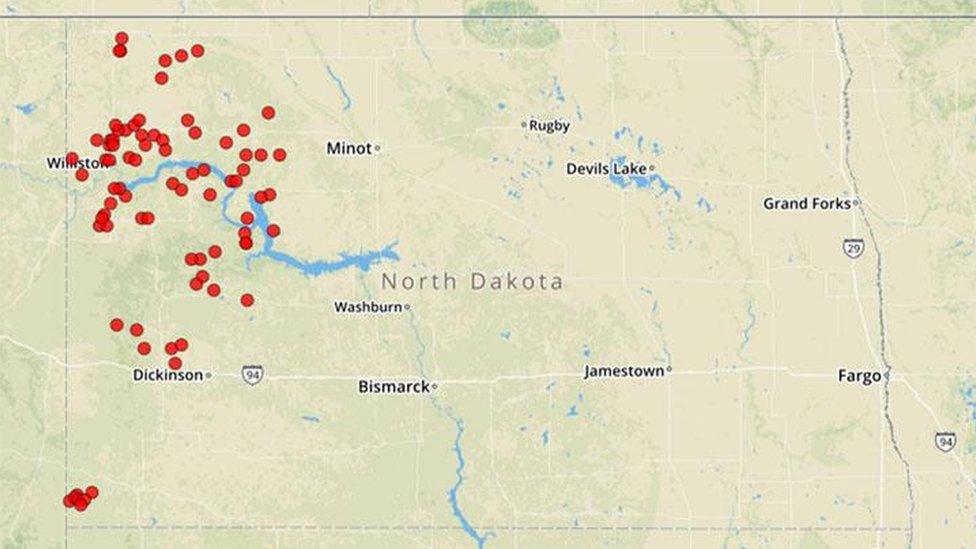Thousands of spills at US oil and gas fracking sites
- Published
- comments

The study found that thousands of spills were reported at oil and gas fracking sites in four states
Up to 16% of hydraulically fractured oil and gas wells spill liquids every year, according to new research from US scientists.
They found that there had been 6,600 releases from these fracked wells over a ten-year period in four states.
The biggest problems were reported in oil-rich North Dakota where 67% of the spills were recorded.
The largest spill recorded involved 100,000 litres of fluid with most related to storing and moving liquids.
Higher numbers
The rapid growth in the extraction of oil and gas from unconventional sources in the US has had a massive impact on the production and consumption of energy over the past ten years.
The key to this expansion has been the use of hydraulic fracturing, external, the process of injecting fluids with chemical additives under pressure to crack underground rock and release the trapped resources.
However, environmental campaigners have long been troubled by the potential for this process to contaminate water supplies and the environment through leaks and spills.
A study carried out by the US Environment Protection Agency, external on fracking in eight states between 2006 and 2012 concluded that 457 spills had occurred.
But this new study, while limited to just four states with adequate data, suggests the level of spills is much higher. The researchers found 6,648 spills between 2005 and 2014.
"The EPA just looked at spills from the hydraulic fracturing process itself which is just a few days to a few weeks," lead author Dr Lauren Patterson from Duke University told BBC News.

A map showing spills sites in North Dakota over the ten years of the study
"We're looking at spills at unconventional wells from the time of the drilling through production which could be decades."
The state reporting the highest level of spills was North Dakota, a hot bed of activity in both oil and gas recovery.
The data recorded 4,453 incidents in the state, much higher than Pennsylvania, Colorado and New Mexico.
This can be explained by reporting requirements. In North Dakota, any spill bigger than 42 US gallons has to be reported while in Colorado and New Mexico the requirement was 210 gallons.
Most of the spills occurred in the first three years of operation. Around 50% of spills were related to the storage and movement of fluids via pipelines. The underlying causes were difficult to determine because of different reporting requirements.
"The causes are quite varied," said Dr Patterson.
"Equipment failure was the greatest factor, the loading and unloading of trucks with material had a lot more human error than other places."
A surprising number of spills occurred at wells which had recorded a previous incident, over half in the case of North Dakota. This suggests that targeted inspections on these sites might have a significant impact in reducing spills.
However industry sources dispute the impact that these spill are having. They argue that very few have resulted in contamination to the environment.
"The reality is that North Dakota requires that companies report any spills that are a barrel or more, even if they never impact the environment - and the vast majority of spills have not," said Katie Brown from Energy in Depth, a body funded by petroleum producing companies.
"According to the North Dakota Department of Health, 70% of all spills in 2013 were contained on the well pad and never reached land or water."
For the authors of the study, the underlying message is that better and more uniform data collection and reporting across different states would allow the industry and environmentalists to better assess the impact of fracked wells on the environment.
"Analyses like this one are so important, to define and mitigate risk to water supplies and human health," said Kate Konschnik, another author on the paper from Harvard Law School's Environmental Policy Initiative.
"Writing state reporting rules with these factors in mind is critical, to ensure that the right data are available - and in an accessible format - for industry, states and the research community."
The study has been published, external in the journal, Environmental Science & Technology.
Follow Matt on Twitter, external and on Facebook, external.